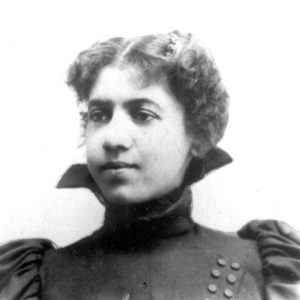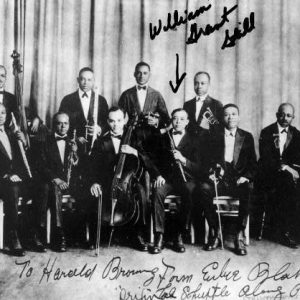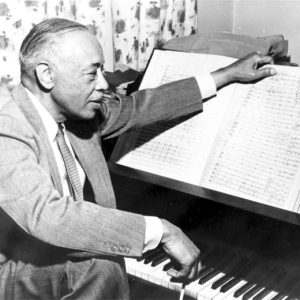calsfoundation@cals.org
William Grant Still (1895–1978)
William Grant Still grew up in Little Rock (Pulaski County) and achieved national and international acclaim as a composer of symphonic and popular music. As an African American, he broke race barriers and opened opportunities for other minorities. He was strong advocate for the performance of works by American composers.
William Grant Still was born on May 11, 1895, in Woodville, Mississippi, the only son of William Grant Still Sr. and Carrie Lena Fambro Still. Still’s mother moved to Little Rock with her infant son shortly after the death of her husband in 1895. Still and his mother lived with his grandmother, and his mother worked as a teacher. In 1904, Still’s mother married a railway postal clerk, Charles Benjamin Shepperson, whose own interest in music influenced the young Still. With Shepperson’s support, he studied violin in 1908 with American violinist William Price, who lived for a short time in Little Rock.
Still attended M. W. Gibbs High School in Little Rock and graduated in 1911 as class valedictorian. That fall, he enrolled at Wilberforce University in Ohio (which was supported by the African Methodist Episcopal Church), where his mother hoped he would pursue studies in medicine. His interest in music, however, led him to leave Wilberforce in early 1915 without graduating in order to play in bands and orchestras in Ohio.
On October 4, 1915, he married Grace Bundy. The couple had four children, but the marriage ended in divorce in 1939.
In 1916, Still was in Memphis, Tennessee, where he met blues musician W. C. Handy, who provided Still with the opportunity to arrange and perform with his band. The next year, he entered the Oberlin Conservatory of Music in Ohio to pursue a formal education in music. Still’s education was interrupted by World War I, when he served in the U.S. Navy. He served as a mess hall attendant and violinist for officers’ meals. He returned to Oberlin after his discharge but did not receive a degree. Instead, in 1919, he moved to Harlem in New York City, where he worked for the Pace and Handy Music Publishing Company and performed with bands and orchestras. He also studied music with George Whitefield Chadwick, director of the New England Conservatory of Music, and Edgard Varese, the French modernist. These diverse experiences provided Still with professional contacts and valuable insight to performing, arranging, orchestrating, and composing popular and symphonic music.
From the Black Belt (1926), From the Land of Dreams (1924), Darker America (1924–1925), From the Journal of a Wanderer (1924), La Guiablesse (1926–1927), and Levee Land (1925) are among the noteworthy works Still composed during his developmental period. The Afro-American Symphony, completed in 1930 and first performed in 1931 by the Rochester Philharmonic Orchestra under conductor Howard Hanson, is Still’s most well-known composition. It was the first symphony composed by an African American that was performed by a major orchestra, and it is still performed today. Hanson later conducted many of Still’s compositions as part of Hanson’s American Composers’ Concerts in Rochester and also in Europe, where he conducted programs of American music.
While living in New York, Still met Paul Whiteman, who hired him to arrange music. When Whiteman took his orchestra to Hollywood, California, in May 1929, Still went, too. During the course of a year, Still completed more than 100 arrangements for Whiteman. Whiteman later commissioned Still to create original compositions, including A Deserted Plantation (1933), Beyond Tomorrow (1936), Land of Superstition (1933), Ebon Chronicle (1934), Down Yonder (circa 1935), and Blues from Lennox Avenue (circa 1937). Still moved permanently to Los Angeles, California, in 1934.
The 1930s and 1940s proved to be quite successful for Still, as major orchestras increasingly performed his compositions. The Chicago Symphony Orchestra performed La Guiablesse, written for the ballet, on June 16, 1933. On November 20, 1935, the New York Philharmonic performed Still’s Afro-American Symphony at Carnegie Hall. Leopold Stokowski and the Philadelphia Symphony premiered his Symphony in G Minor on December 10, 1937. Still wrote the theme music for the 1939–1940 New York World’s Fair. Song of a City, once recorded, was played 31,857 times at the fair, according to New Yorker magazine. The New York Philharmonic first performed And They Lynched Him on a Tree on June 24, 1940, at Lewisohn Stadium. The New York Philharmonic also premiered Plain-Chant for America on October 23, 1941, and The Colored Soldiers Who Died for Democracy on January 5, 1944, both at Carnegie Hall. The Cleveland Orchestra premiered Poem for Orchestra on December 7, 1944, and the Cincinnati Symphony Orchestra premiered Festive Overture on January 19, 1945. The opera Troubled Island, with a libretto by poet Langston Hughes, was premiered by the New York City Opera Company on March 31, 1949.
Two days after his divorce from Grace Bundy on February 6, 1939, he married Verna Arvey in Mexico where interracial marriages were legal. Arvey was an accomplished pianist and excellent writer, talents that served her husband well for over forty years. They had two children.
Still’s compositions include symphonies, ballets, operas, chamber music, and works for solo instruments. Together, they number almost 200 pieces. His lengthy list of honors and awards includes the William E. Harmon Award for Distinguished Achievement among Negroes in Music in 1928; the Guggenheim Fellowship in 1934, 1935, and 1938; the Julius Rosenwald Foundation Fellowship in 1939 and 1940; and a Freedoms Foundation Award in 1953. He received honorary degrees from the following institutions: Wilberforce University in 1936; Howard University in 1941; Oberlin College in 1947; Bates College in 1954; University of Arkansas in Fayetteville (Washington County) in 1971; Pepperdine University in 1973; Peabody Conservatory of Music in 1974; and the University of Southern California in 1975.
Still’s health began to decline in 1970. He spent his last years in a convalescent home and died in Los Angeles on December 3, 1978. His ashes were scattered over the Pacific Ocean. He was posthumously inducted into the Arkansas Entertainers Hall of Fame and the Arkansas Black Hall of Fame.
For additional information:
Arvey, Verna. In One Lifetime. Fayetteville: University of Arkansas Press, 1984.
———. Studies of Contemporary American Composers: William Grant Still. New York: J. Fischer, 1939.
Dunn Powell, Rosephanye. “The Solo Vocal Writing Style of William Grant Still.” DMus diss., Florida State University, 1993.
Edwards, Benjamin Griffin. “The Life of William Grant Still.” PhD diss., Harvard University, 1987.
Farrah, Scott David. “Signifyin(g): A Semiotic Analysis of Symphonic Worlds by William Grant Still, William Levi Dawson, and Florence B. Price.” PhD diss., Florida State University, 2007.
Fleishman, Jeffrey. “Black composer William Grant Still Drew from the Blues; Forty Years after His Death, He Still Fights to be Heard.” Los Angeles Times, February 13, 2019. Online at https://www.latimes.com/entertainment/arts/culture/la-et-cm-william-grant-still-la-phil-20190213-story.html (accessed April 16, 2021).
Hudgins, Mary D. “An Outstanding Arkansas Composer, William Grant Still.” Arkansas Historical Quarterly 24 (Winter 1965): 308–314.
Hussung, Mark Edward. “The Solo Piano Works of William Grant Still.” DMA diss., University of Cincinnati, 1998.
Lamb, Earnest. “Still Life in Black and White: An Intertextual Interpretation of William Grant Still’s “Symphonic Trilogy.” PhD diss., University of North Texas, 2005.
Murchison, Gayle. “‘Dean of Afro-American Composers’ or ‘Harlem Renaissance Man’: The New Negro and the Musical Poetics of William Grant Still.” Arkansas Historical Quarterly 53 (Spring 1994): 42–74.
Smith, Catherine Parsons. William Grant Still. Champaign: University of Illinois Press, 2008.
———. William Grant Still: A Study in Contradictions. Berkeley: University of California Press, 2000.
Still, Judith Anne, Celeste Anne Headlee, and Lisa M. Headlee-Huffman, eds. William Grant Still and the Fusion of Cultures in American Music. 2nd ed. Flagstaff, AZ: The Master-Player Library, 1995.
Still, Judith Anne, Michael J. Dabrishus, and Carolyn L. Quinn. William Grant Still: A Bio-Bibliography. Westport, CT: Greenwood Press, 1996.
Still, William Grant. My Life, My Words: The Autobiography of William Grant Still. Flagstaff, AZ: The Master-Player Library, 2011.
William Grant Still and Verna Arvey Papers. Special Collections. University of Arkansas Libraries, Fayetteville, Arkansas.
Michael J. Dabrishus
University of Pittsburgh
This entry, originally published in Arkansas Biography: A Collection of Notable Lives, appears in the CALS Encyclopedia of Arkansas in an altered form. Arkansas Biography is available from the University of Arkansas Press.
 Arts, Culture, and Entertainment
Arts, Culture, and Entertainment Early Twentieth Century, 1901 through 1940
Early Twentieth Century, 1901 through 1940 Music and Musicians
Music and Musicians Carrie Shepperson
Carrie Shepperson  William Grant Still
William Grant Still  William Grant Still
William Grant Still  William Grant Still
William Grant Still 




Comments
No comments on this entry yet.